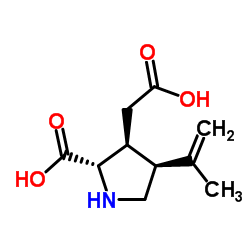Kainic acid hydrate

Kainic acid hydrate structure
|
Common Name | Kainic acid hydrate | ||
|---|---|---|---|---|
| CAS Number | 58002-62-3 | Molecular Weight | 213.230 | |
| Density | 1.2±0.1 g/cm3 | Boiling Point | 439.9±45.0 °C at 760 mmHg | |
| Molecular Formula | C10H15NO4 | Melting Point | 250-252°C | |
| MSDS | USA | Flash Point | 219.8±28.7 °C | |
|
MicroRNA-124 and -137 cooperativity controls caspase-3 activity through BCL2L13 in hippocampal neural stem cells.
Sci. Rep. 5 , 12448, (2015) Adult neurogenesis continuously contributes new neurons to hippocampal circuits and the programmed death of a subset of immature cells provides a primary mechanism controlling this contribution. Epileptic seizures induce strong structural changes in the hippo... |
|
|
Nodule excitability in an animal model of periventricular nodular heterotopia: c-fos activation in organotypic hippocampal slices.
Epilepsia 56(4) , 626-35, (2015) Aberrations in brain development may lead to dysplastic structures such as periventricular nodules. Although these abnormal collections of neurons are often associated with difficult-to-control seizure activity, there is little consensus regarding the epilept... |
|
|
Plasticity of calcium signaling cascades in human embryonic stem cell-derived neural precursors.
Stem Cells Dev. 22(10) , 1506-21, (2013) Human embryonic stem cell-derived neural precursors (hESC NPs) are considered to be a promising tool for cell-based therapy in central nervous system injuries and neurodegenerative diseases. The Ca(2+) ion is an important intracellular messenger essential for... |
|
|
CNS oxidative stress associated with the kainic acid rodent model of experimental epilepsy.
Epilepsy Res. 39 , 63-71, (2000) The role of oxidative stress in seizure-induced brain injury was investigated in a kainic acid model of experimental epilepsy. Kainic acid (12.5 mg/kg) or saline was injected intraperitoneally into 12-week-old male Fischer 344 rats and sacrificed by decapitat... |
|
|
Neuroprotection requires the functions of the RNA-binding protein HuR.
Cell Death Differ. 22(5) , 703-18, (2015) Alterations in the functions of neuronal RNA-binding proteins (RBPs) can contribute to neurodegenerative diseases. However, neurons also express a set of widely distributed RBPs that may have developed specialized functions. Here, we show that the ubiquitous ... |
|
|
Adeno-associated viral vector-induced overexpression of neuropeptide Y Y2 receptors in the hippocampus suppresses seizures.
Brain 133 , 2778-88, (2010) Gene therapy using recombinant adeno-associated viral vectors overexpressing neuropeptide Y in the hippocampus exerts seizure-suppressant effects in rodent epilepsy models and is currently considered for clinical application in patients with intractable mesia... |
|
|
Lack of kainic acid-induced gamma oscillations predicts subsequent CA1 excitotoxic cell death.
Eur. J. Neurosci. 30(6) , 1036-55, (2009) Gamma oscillations are a prominent feature of hippocampal network activity, but their functional role remains debated, ranging from mere epiphenomena to being crucial for information processing. Similarly, persistent gamma oscillations sometimes appear prior ... |
|
|
Interactions between mitochondrial bioenergetics and cytoplasmic calcium in cultured cerebellar granule cells.
Cell Calcium 34 , 407-424, (2003) The mitochondrion has moved to the center stage in the drama of the life and death of the neuron. The mitochondrial membrane potential controls the ability of the organelle to generate ATP, generate reactive oxygen species and sequester Ca(2+) entering the ce... |
|
|
Striatal lesions interfere with acquisition of a complex maze task in rats.
Behav. Brain Res. 197 , 138-43, (2009) The 14-unit T-maze has proven to be a valuable tool for investigating age-associated memory impairment (AAMI). While another task widely used to evaluate AAMI, the water maze, is primarily used to evaluate allocentric hippocampal-dependent spatial memory, the... |
|
|
Molecular imaging of retinal gliosis in transgenic mice induced by kainic acid neurotoxicity.
Invest. Ophthalmol. Vis. Sci. 50 , 2459-64, (2009) Gliosis is a universal response of the central nervous system to diverse insults. Here the authors aimed to develop a noninvasive fluorescence system to monitor and quantify retinal gliosis in real time.Transgenic mice expressing green fluorescent protein (GF... |